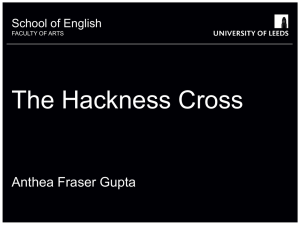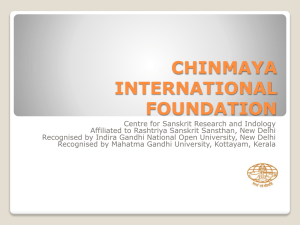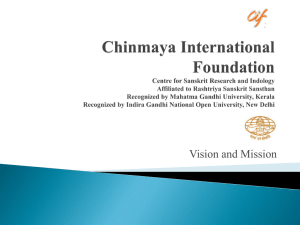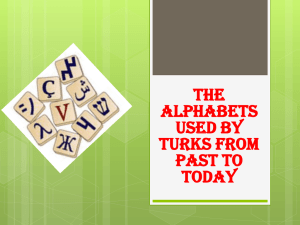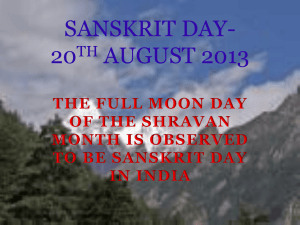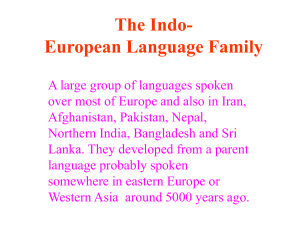Presentation4
advertisement
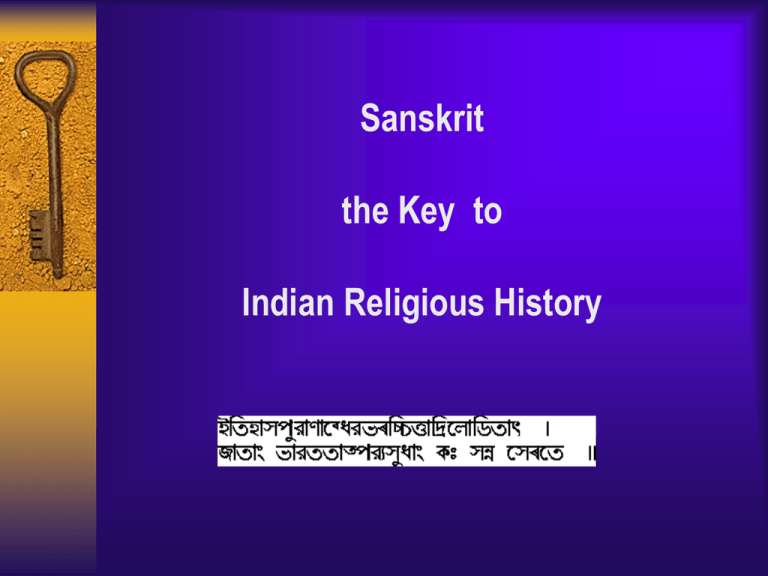
Sanskrit the Key to Indian Religious History I. The Brahmi alphabet of northwestern India of the 3rd century B.C., generally called the Mauryan alphabet, is represented in: (1) The Kalsi Rock Edicts (2) The Delhi-Topra pillar-edicts (3) The Pathyar (District Kangra, Himachal Pradesh) rock inscription 3c BC 2c BC I. The Brahmi alphabet of north-western India of the 3rd century B.C. II. The Brahmi alphabet of northwestern India of the 2nd century B.C. to the beginning of the Christian era, usually called the post-Mauryan alphabet, is represented among others by the following records: 1. The coins of the Indo-Grecian Kings Agathocles the Pantaleon 2. The inscriptions of the ksatrapa Sodasa 3. The Kanhiar (Dist. Kangra, H.P.) rock inscription 4. The Bathtsal (Jammu) cave inscription I. The Brahmi alphabet of north-western India of the 3rd century B.C. II. The Brahmi alphabet of north-western India of the 2nd century B.C. to the beginning of the Christian era, usually called the post-Mauryan alphabet, .. III. The inscriptions of the Kusana kings-Kaniska, Huviska and Vasudeva, discovered form Mathura and its vicinity, illustrate the next step in the develcpment of the Brahmi of north-western India. Mid 2 c BC – 3 c AD I. The Brahmi alphabet of north-western India of the 3rd century B.C. II. The Brahmi alphabet of north-western India of the 2nd century B.C. to the beginning of the Christian era, usually called the post-Mauryan alphabet, .. III. The inscriptions of the Kusana kings 4c – 5c AD IV. Further development of our alphabet is illustrated by the following records of the 4th and 5th centuries A.D. which represent the western variety of the northern Indian alphabet of the 4th and 5th centuries A.D., generally called the Gupta alphabet: 1. The Abbotabad inscription of the time of Kadambesvara dasa (Gupta) year 25 = A.D. 344 2. The Mathura inscription of Chandragupta II, G.E. 61 = A.D. 380 3. The Mathura stone inscription of Chandragupta II 4. The Shorkot inscription of the year 83 5. The Tussam (Dist. Hissar) rock inscription 6. The Lahore copper seal inscription of the Maharaj Mahesvaranaga 7. The Bower manuscript I. The Brahmi alphabet of north-western India of the 3rd century B.C. II. The Brahmi alphabet of north-western IV. 4th and 5th centuries India of the 2nd century B.C. to the beginning of the Christian era, usually A.D.== western variety of the called the post-Mauryan alphabet, .. northern Indian alphabet of the 6c – 7c AD III. The inscriptions of the Kusana kings 4th and 5th centuries A.D., called the Gupta alphabet: V. In the following records of the 6th and the 7th centuries A.D., discovered in northwestern India, we find further development of the forms of the Western Gupta alphabet leading to those of the Sharada in the 9th century. 1. Kura inscription of Toramana 2. The Nirmand plate of Mahasamanta Maharaja Samudrasena 3. The Sonepat Seal of Harsavardhana 4. The Hatun rock inscription of Patoladeva 5. The Gilgit manuscripts The basic Brahmi script 5th century BCE to 4th century CE Development of Indian Languages from Brahmi Script The first epigraphic evidence of Sanskrit is seen in 150 AD and this inscription is in the Brahmi script. (Encyclopedia Britannica, 1982). From the fifth century A.D. classical Sanskrit is seen to be the dominant language in the inscriptions. Earlier documents used Pali and Prakrit Asoka who took every care to make his messages intelligible to the common man and used all existing scripts and languages. These 3rd Centaury inscriptions do not include Sanskrit. It included Prakrit, Greek and Aramaic. But no Sanskrit is found because it was not in existence at that time Sanskrit was developed out of Prakrit and other existing languages during the interval of 100 AD to 150 AD Classical Sanskrit is found as an inscription dating around A.D.150 in the Brahmi script .It records the repair of a dam originally built by Chandragupta Maurya, and also contains a panegyric in verse, which can be regarded as the first literary composition in classical Sanskrit. It is at Girnar in Kathiawar and was inscribed by Rudradamana, the Saka Satrap of Ujjayini, on the same rock on which the Fourteen Rock Edicts of Asoka were also found. 750 BCE: vedic (Sanskrit?) 500 BCE: Prakrit texts of Buddhists and Jains 400 BCE: Panini composes his Sanskrit grammar transition from Vedic to Paninian Sanskrit 322 BCE: Brahmi script inscriptions by Mauryas in Prakrit (Pali) 250 BCE: Classical Sanskrit emerges. 100 BCE-100 AD: Sanskrit gradually replaces Prakrit in inscriptions 320 AD The Gupta or Siddha-matrika script emerges. http://www.cs.colostate.edu/~malaiya/hindiint.html Thus apart from portions of the Veda which were not written in Sanskrit, all other Vedas, Upanishads, Brahmanas and Puranas etc were written down later than 100 AD at liberal estimate. They must have been written down much later in actual fact. A more realistic estimate will be around 6th Centaury AD. FOUR VEDAS UPANISHADS, BRAHMANAS, PURANAS BC AD Thus for instance the vast amalgamation of Puranic tradition known as the Skandapurana, as far as we can speak of it as a single work at all, cannot be older than the 16th century, as has been shown in the Groningen Skandapurana project (see Adriaensen et al 1994). It should be noted here that the names of the gods and the Rishis with which each Sukta begins were selected long after the collection of the VEDAS. These were determined in the Index known as the Anukramanee. Katyayana composed the Anukramanee, which has been followed in the Rik-Sanhita in adopting the names of the gods and the rishis. Katyayana came after Yáska and it is therefore evident that the names were invented many centuries afterwards without having any historic truth in them. There is nothing in the Suktas themselves, which can throw any light in elucidating these words. Rajeswar Gupta http://phoenicia.org/rigveda.html If the horoscope given to us is correct Krishna was born in the month of Sravana on the 23rd day on the night of full moon in Lagnam Edavam at midnight and if Guru (Mars), Kujan (Mercury), Ravi (Sun) and Sukran (Venus) were at their own home, Budan, Chandran (moon) and Sani (Saturn) were in their highest time, then Krishna was born in AD 600. Dates for Panini are pure guesses 5c BC “ Mahabaharatha as given to us could not have been written before A.D fourth Centaury. Panini, who is the famous grammarian, has mentioned several important personalities of the epics of that period. While the reprints published later have made several errors, variations and exaggerations, the main characters and the imports of the stories remain in tact. There is no doubt that Geetha came into existence only during the period of Gupta Empire.” K.M.Panicker ( A Survey of Indian History p.67) 400 AD Manu 1500 BC? It is certain that Manu did not know anything about the Trinity or their functions as Creator, Sustainer and Destroyer. Yet by A.D 6th Centaury this concept was popular as is clear from the works of Kalidasa Ramesh Chandra Dutt, History of Civilizations in India Vol II P.191 Kalidasa 3c AD As the story is woven, the imagination of the storyteller takes control and describes these in vivid details and normal human life situations. Thus even the Gods are presented with human qualities and falls into acts of immorality, jealousy and fight. We thus have imaginative weapons and methods of warfare. Because art forms of this type were basically presented through the temple, these took on the form of “scripture”.

